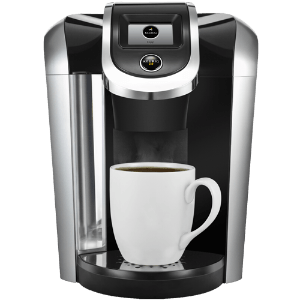
Most of Keurig Green Mountain's facilities are in low water risk regions, except for the one in Castroville, California. That facility is located in Monterey County, which, like nearly the entire state, is suffering a severe drought. The good news is that Keurig’s Castroville facility only withdraws a small amount of water from local supplies. That's great in a county so drought-stricken that does not allow some of its residents to do outdoor watering during the day.
Keurig’s latest sustainability report points out that the Keurig brewing system actually reduces water use as compared to conventional systems, as it uses only the amount of water that will be consumed. (About 12 to 15 percent of home brewed coffee is wasted, on average, the company said.)
Keurig conducted a water footprint analysis related to the manufacturing and use of its coffee portion packs. What the water footprint showed is that it is not a large direct consumer of water. That’s a good thing, particularly for this California girl.
Keurig is also concerned about waste. That’s why the company set a lofty goal: achieving zero-waste-to-landfill at the company’s owned and operated manufacturing distribution facilities by 2020. It is on track to meet the commitment, as it achieved an 86 percent diversion rate in 2014 -- an increase from 73 percent in 2013. Low water use and a focus on waste reduction? That’s enough goodness to prompt me to consider buying one of its brewing systems.
Oh, there’s more goodness: Keurig has a goal to reduce the greenhouse gas (GHG) emissions of brewed beverages by 25 percent by 2020. It achieved a 4 percent reduction in energy used for its coffee roasting process last year.
Keurig also did a comprehensive GHG footprint of its coffee value chain last year, from coffee beans cultivation to product end-of-life. What the company found is that the biggest contributor to its GHG footprint (about 55 percent) comes from brewer energy use. By the end of this year, the company will have reduction plans in place to meet its 2020 target.
K-Cup packs aren't recyclable ... yet
Alas, there is something holding me back from buying one of Keurig's single-use brewing systems, and that’s the waste each K-Cup creates. There are two features that prevent the present K-Cup packs from being recyclable. The plastic cup has to be separated from the lid and filter for the cup to be recycled. The filter is sealed to the plastic cup and that makes it difficult to separate the lid, filter and cup. The filter is also a blend of natural fibers and plastic, and that prevents it from being recycled conventionally.
Although the company has a goal to make its K-Cup packs 100 percent recyclable by 2020, it is not there yet. However, to achieve that goal, the company is “testing key design concepts for a K-Cup pack that can be easily separated and readily recycled,” as stated in its report. To that end, Keurig is investing $5 million over five years in coming up with solutions to achieve its goal through the Closed Loop Fund.
Image credit: Keurig Green Mountain, Inc.

Gina-Marie is a freelance writer and journalist armed with a degree in journalism, and a passion for social justice, including the environment and sustainability. She writes for various websites, and has made the 75+ Environmentalists to Follow list by Mashable.com.














